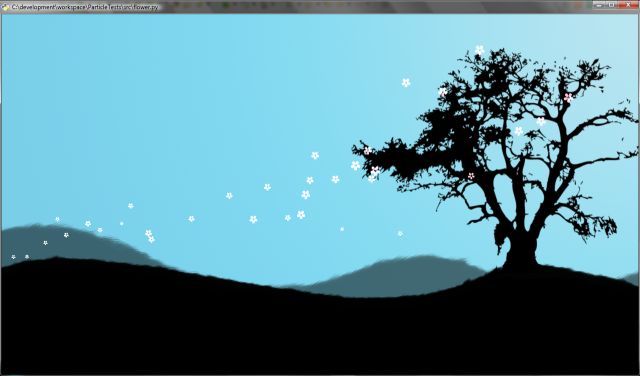Animating a Scene with pyglet - first version
Last Update: 28.11.2009. By azarai in pyglet | python
Some time after i wrote (Rendering particles in realtime with py-lepton)[http://codeboje.de/Rendering-particles-in-realtime-with-py-lepton/ “Rendering particles in realtime with py-lepton”], i got the idea of creating an animated scene with “flowers falling from a tree and get blown away by wind”. Today i got the time to actually code a first simple version.
Update 30.Nov: Added download incl. images at the bottom.
Screenshot:

Here is the code of the animated scene. I made comments in the code that should explain everything. I use py-lepton for the wind effect and 4 lepton domains of controlling the flow of the flowers. But its not looking natural yet. I’d appreciate any critique & comments.
from lepton import Particle, ParticleGroup, default_system
from lepton.renderer import BillboardRenderer
from lepton.texturizer import SpriteTexturizer
from lepton.emitter import StaticEmitter
from lepton.controller import Gravity, Lifetime, Movement, Growth, Magnet
from lepton.domain import Disc
import pyglet
from pyglet.gl import *
from pyglet import image
#create pyglet window
window = pyglet.window.Window(width=1280, height=720, visible=False)
window.clear()
#enable alpha blending
glEnable(GL_BLEND)
glShadeModel(GL_SMOOTH)
glBlendFunc(GL_SRC_ALPHA,GL_ONE)
glDisable(GL_DEPTH_TEST)
def get_color(r,g,b,a):
""" converts rgba values of 0 - 255 to the equivalent in 0 - 1"""
return (r/255.0,g/255.0,b/255.0, a/255.0)
flower_tex = image.load('textures/flower.png').get_texture()
background = image.load('textures/bg.png').get_texture()
## create domain for wind effect
wind_domain = Disc((782, 230, 0),(0,1,0), 300, 10) #in the hollow, pushes flowers away
wind_domain2 = Disc((350, 180, 0),(0.5,0.5,0), 100, 10) #at the left hill, right side before top
wind_domain3 = Disc((480, 400, 0),(1,0,0),100, 10) # above between first to domains
wind_domain4 = Disc((1044, 420, 0),(1,0,0), 200, 50) # in the tree, pulling flowers
# create 3 flower emitters at different positions
flower_emitter = StaticEmitter(
rate = 1,
template=Particle(
position=(786,439),
size=(20,20,0),
velocity=(-20,0,0),
color= get_color(255, 192, 213,255),
),
deviation=Particle(
position=(20,20,0.10),
velocity=(20,50,0),
),
)
flower_emitter2 = StaticEmitter(
rate = 1,
template=Particle(
position=(1126,579),
size=(20,20,0),
velocity=(-20,0,0),
color= get_color(255, 192, 213,255),
),
deviation=Particle(
position=(20,20,0),
velocity=(20,50,0),
),
)
flower_emitter3 = StaticEmitter(
rate = 1,
template=Particle(
position=(961,582),
size=(20,20,0),
velocity=(-20,0,0),
color= get_color(255, 192, 213,255),
),
deviation=Particle(
position=(20,20,0),
velocity=(20,50,0),
),
)
# use default_system and set global controllers, so that flowers are emitted at a constant rates
default_system.add_global_controller(
Lifetime(20),
Movement(damping=0.93),
Growth(-1),
Gravity((-120, -60, 0)),
Magnet(wind_domain, charge=-150000.0),
Magnet(wind_domain2, charge=-150000.0),
Magnet(wind_domain3, charge=10000.0),
Magnet(wind_domain4, charge=2000.0),
)
flowers = ParticleGroup(
controllers=[
flower_emitter, flower_emitter2, flower_emitter3
],
renderer=BillboardRenderer(SpriteTexturizer(flower_tex.id)))
# clear screen and draw particles
@window.event
def on_draw():
window.clear()
background.blit(0,0)
glLoadIdentity()
default_system.draw()
# setup scheduler for particle updates and start pyglet
if __name__ == '__main__':
window.set_visible(True)
pyglet.clock.schedule_interval(default_system.update, (1.0/30.0))
pyglet.clock.set_fps_limit(None)
pyglet.app.run()



